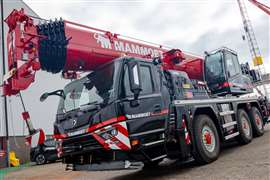Pipe routing
30 April 2008
In 2004 Emmert International was awarded a contract from a fabrication company in North Texas to transport a total of 18 pipe rack modules to a reffinery in South Texas. The haul would cover more than 20,880 miles of roadway within a six–week period.
The pipe rack modules had a gross loaded weight of 140,000 pounds, overall length of 90 feet, overall width of 18 feet, and overall height of 20 feet. Transporting them would require the use of a four–axle, single–drop, stretch–deck trailer, pulled by a four–axle tractor. Th is combination kept the axle groupings within legal limits to obtain permits, and a total of five such units were required to transport so many modules in the short time available.
The dimensions of the load made it difficult to find a route, because trees, wires, and low overhead clearances were potential problems. All planning and permits needed for the job depended on the clearances around the loaded pipe rack modules.
To identify a suitable route, affected cities and counties were contacted to discuss the requirements for the large components. Then a physical route survey was performed to locate problems areas. All concerns were identified and a suitable–to–all route was determined.
Each load was escorted by bucket trucks. These trucks lifted all overhead power, trafi c lights and phone lines so that the pipe racks could safely pass underneath. Tree limbs and signs along the route also had to be moved. The lead escort used a height stick to ensure the proper clearance was achieved, while a rear pilot car controlled trafi c, especially in restricted passing areas.
The timing of each delivery was crucial, due to the shortage of unload space at the destination. An off–site staging area was established to accommodate the pipe racks while the site was prepared. The racks were then delivered to the site's off–loading area with only an hour's notice in order to maintain the critical path of the customer's project schedule.
In total, Emmert International completed the 18 round trips for all modules with a total gross weight of 2,520,000 pounds covering an excess of 20,880 miles within six–weeks. Even with all the time restrictions and off–loading requirements at the destination, all 18 loads were delivered on time and within budget.
STAY CONNECTED


Receive the information you need when you need it through our world-leading magazines, newsletters and daily briefings.
CONNECT WITH THE TEAM











